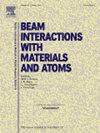用彩虹散射效应表征薄晶体
IF 1.4
3区 物理与天体物理
Q3 INSTRUMENTS & INSTRUMENTATION
Nuclear Instruments & Methods in Physics Research Section B-beam Interactions With Materials and Atoms
Pub Date : 2025-07-14
DOI:10.1016/j.nimb.2025.165790
引用次数: 0
摘要
这项研究提出了一种新的方法来表征非常薄的晶体,利用彩虹散射理论在通道模式下,一种以前没有应用于此目的的技术。我们探索了这种方法对晶体结构和性质的详细分析的潜力。为了表征超薄晶体,我们采用数值模拟方法来模拟和分析彩虹在通道模式下的散射。设计了模拟来预测质子在不同取向和结构构型的立方晶体中通道的散射模式。这个框架使我们能够生成关于各种参数如何影响质子散射行为的详细预测。数值模拟的整合揭示了不同的彩虹散射模式,为分析晶体的内部结构和方向提供了有价值的见解。通道模式下彩虹散射的数值模拟方法为超薄晶体的表征提供了一种新颖而有效的技术,同时为未来的实验分析奠定了基础。本文章由计算机程序翻译,如有差异,请以英文原文为准。
Characterization of thin crystals by rainbow scattering effect
This study presents novel approach to characterizing very thin crystals using the theory of rainbow scattering in channeling mode, a technique that hasn’t been previously applied for this purpose. We explore potential of this approach for detailed analysis of crystal structures and properties. For characterization of very thin crystals, we employed numerical simulation methods to model and analyze rainbow scattering in channeling mode. Simulations were designed to predict the scattering patterns of protons channeled through cubic crystals in different orientations and structural configurations. This framework enabled us to generate detailed predictions regarding how various parameters influence proton scattering behavior. The integration of numerical simulations revealed distinct rainbow scattering patterns, offering valuable insights into the internal structures and orientations of analyzed crystals. Rainbow scattering in channeling mode with numerical simulation methods introduces a novel and effective technique for characterization of very thin crystals, while laying the groundwork for future experimental analysis.
求助全文
通过发布文献求助,成功后即可免费获取论文全文。
去求助
来源期刊
CiteScore
2.80
自引率
7.70%
发文量
231
审稿时长
1.9 months
期刊介绍:
Section B of Nuclear Instruments and Methods in Physics Research covers all aspects of the interaction of energetic beams with atoms, molecules and aggregate forms of matter. This includes ion beam analysis and ion beam modification of materials as well as basic data of importance for these studies. Topics of general interest include: atomic collisions in solids, particle channelling, all aspects of collision cascades, the modification of materials by energetic beams, ion implantation, irradiation - induced changes in materials, the physics and chemistry of beam interactions and the analysis of materials by all forms of energetic radiation. Modification by ion, laser and electron beams for the study of electronic materials, metals, ceramics, insulators, polymers and other important and new materials systems are included. Related studies, such as the application of ion beam analysis to biological, archaeological and geological samples as well as applications to solve problems in planetary science are also welcome. Energetic beams of interest include atomic and molecular ions, neutrons, positrons and muons, plasmas directed at surfaces, electron and photon beams, including laser treated surfaces and studies of solids by photon radiation from rotating anodes, synchrotrons, etc. In addition, the interaction between various forms of radiation and radiation-induced deposition processes are relevant.

 求助内容:
求助内容: 应助结果提醒方式:
应助结果提醒方式:


